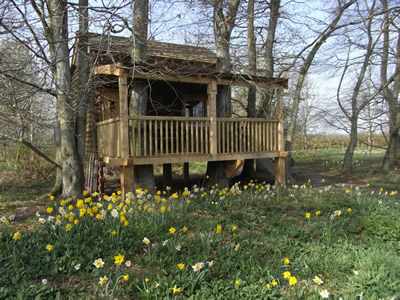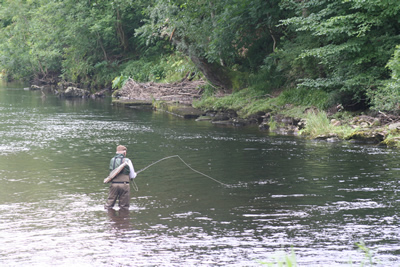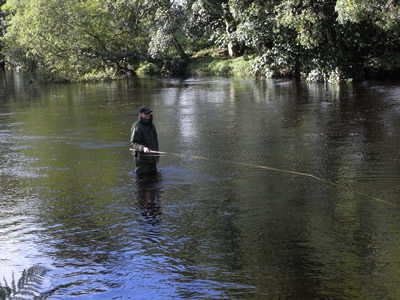An Angus councillor who retired at the end of March pointed out to my wife, Alison, yesterday that there has been no rain in Angus since 31/3, which explains why the catch has dropped away to nothing. There are fish – both salmon and sea trout – in the main pools, but they are virtually impossible to catch. Today there are signs that the weather might be changing, but the rain is at best desultory, and I don’t really expect much from it. But the sky is reassuringly dark and the cloud line on the hills is at about 1200 feet. Maybe….
One of the good things about the first low water of the year is that it allows us to look at the banks and beds of the pools to see what the winter scour has done to the river. At Finavon, bar the odd new pocket or scallop downstream of long established lie boulders, the answer is “not very much”. I can say that the water is crystal clear and that there are healthy showings of parr in all the pool tails and riffles, that the sandpipers and kingfishers are back and there are spoors of otters, and roe deer slots, on the sandy shore of the lower Red Brae. The first grass cut of the season is complete and Jeff Sanderson, the owner of Finavon Hill, has given us a spectacular new access track off the Finavon Hill road about 200 yards up the hill from Fortesk. The old access road is now closed. Scottish Water has donated the aqueduct at Haughs of Finavon to FCW, and we plan to convert it into a useful footbridge, with a lockable gate to restrict access to all except our fishermen and locals only (for liability reasons)
This is the Castle Beat Fishing hut “David’s Treehouse” at daffodil time” 2011
A concerted attack has now started on the giant hogweed, thanks to the good work of the Esk Fisheries Trust under Marshall Halliday’s leadership, and plans are afoot for dealing with the outbreak of Japanese knotweed on Bogardo Beat. Although I say it myself (but I didn’t do the work, so praise is due elsewhere!) the whole FCW beat is looking terrific. The 4 huts are clean and ready for our tenants, and vegetation next to the access tracks and car parks trimmed back so that rods and flies don’t get caught up, and cars unscratched by lurking brambles etc. We are ready for the fish to arrive, and then our syndicates and tenants – in that order!
But first we need water. I have never seen the river so low at the beginning of May.
To date we have 15 spring salmon and, although there is the odd sea trout in the beat (I saw one of about 3.5 lbs in Tyndals two days ago), we have only had one so far. Of course the nets are now back on and it will be interesting to see how George Pullar and his team get on. They should catch a few fish in this low water because virtually nothing is entering the river. My view is that there was a reasonable run of fish until the drought dried them up. I hope our next blog will bring better news.
TA


